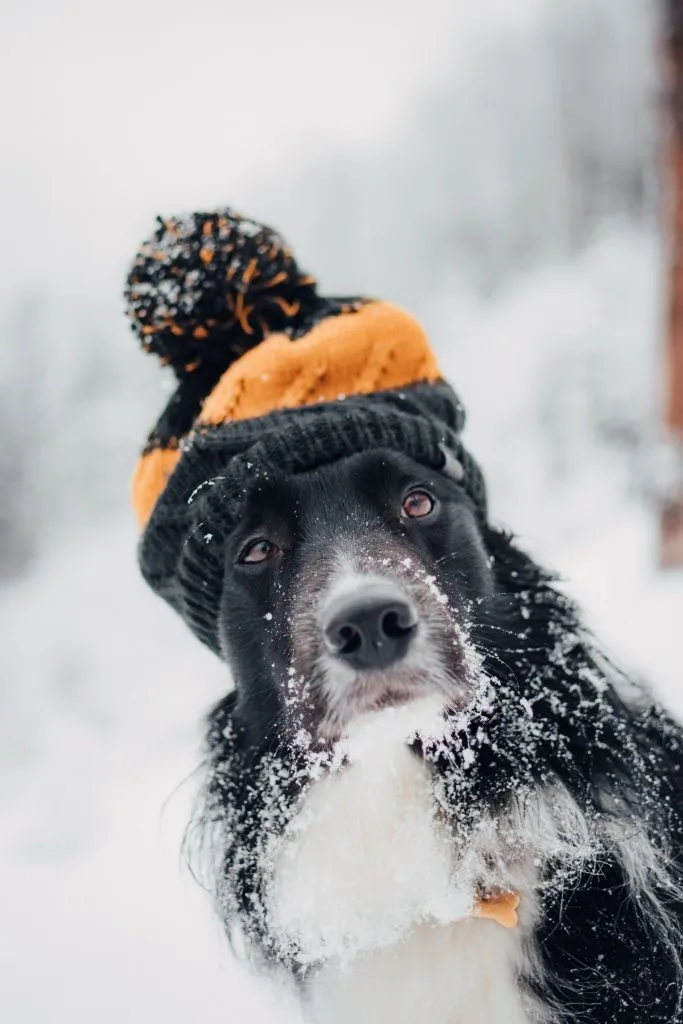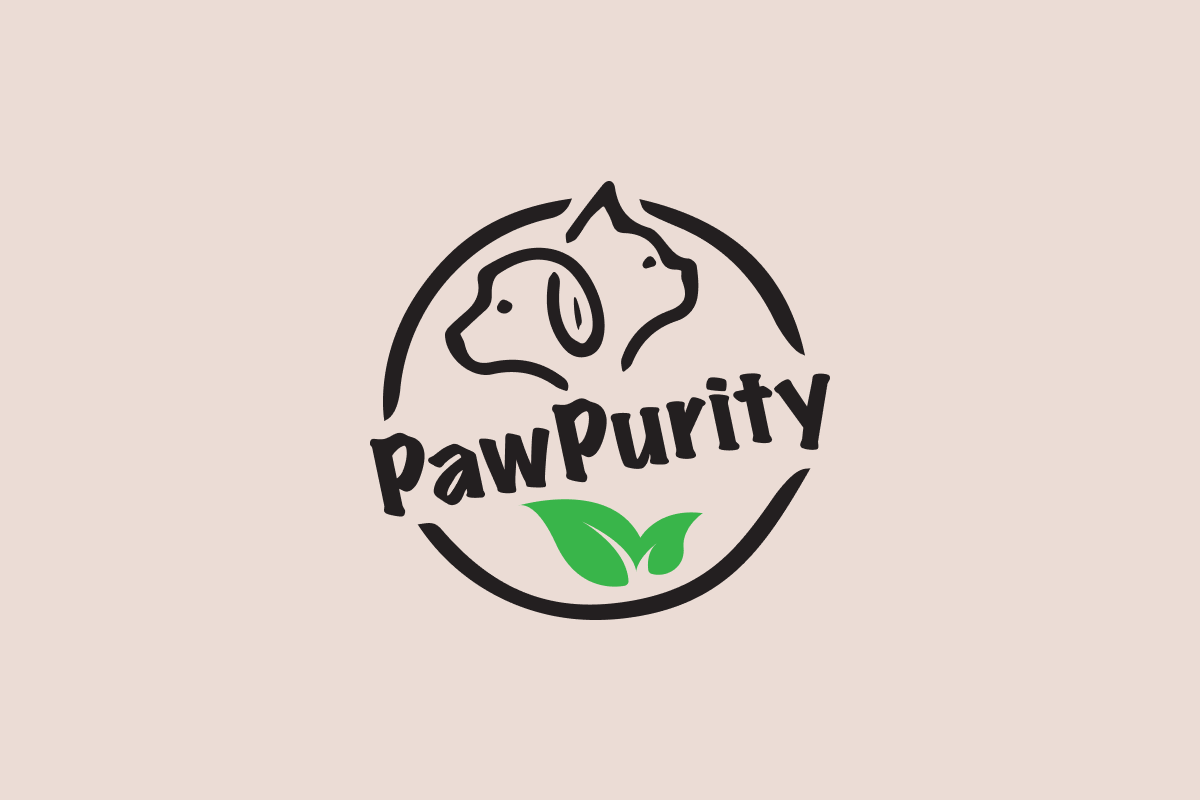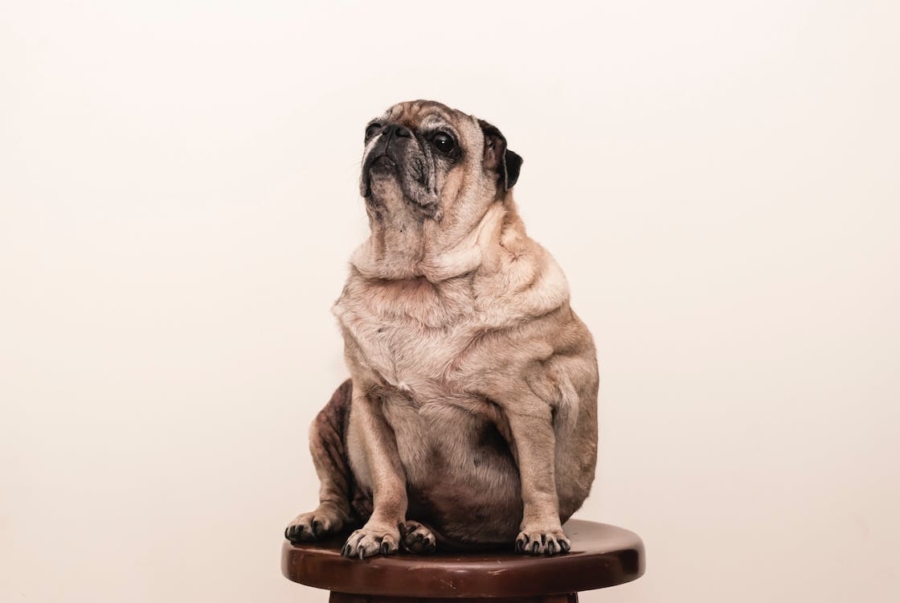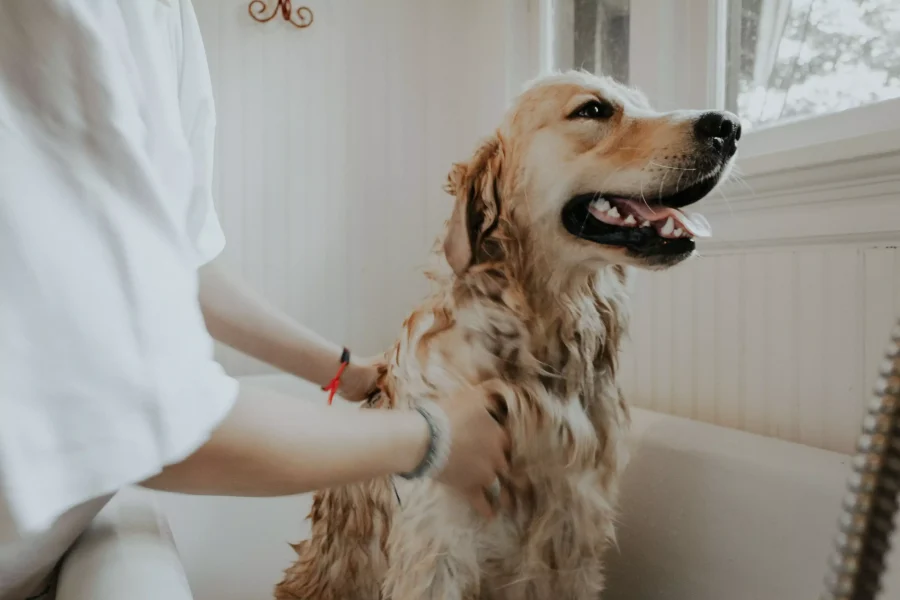Dogs are known for being able to handle cold weather fairly well. Their fur coats protect them from cold temperatures and they enjoy running around in the snow. But what about their paws? Can dog paws handle snow? And if not, what can help them stay safe in the winter weather? In this blog post, we’ll look at some of the issues that can occur when dogs walk on snow and ice and provide tips for keeping your furry friend safe during the winter months.
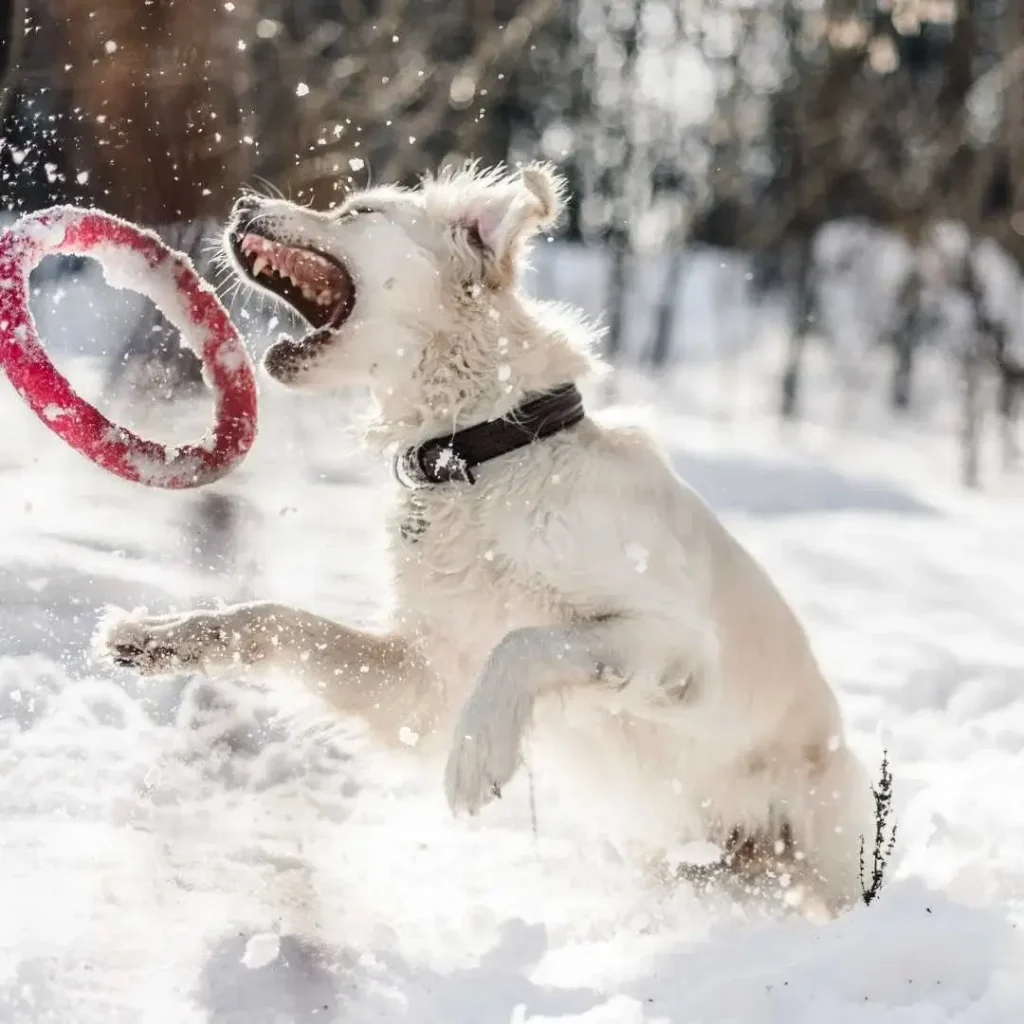
Dogs And Snow – A Love/Hate Relationship
Ah, wintertime. We anticipate the snow and all that comes with it – snowball fights, hot chocolate by the fire, and a canine running around in the white stuff! Some dogs love playing in the snow and can’t get enough of it – but for others, their paws just don’t seem to agree. Dog’s paws and snow have a bit of a love-hate relationship.
For some pups, their feet are just too sensitive for cold weather, walking, or playing outside. It’s not uncommon for dogs to develop cracked pads during winter months due to icy terrain or de-icing chemicals used on roads and sidewalks that can irritate or, worse yet – cause chemical burns. The salt used on our streets also poses an issue.
How To Prepare Your Dog For The Snow?
First, consider the type of coat your dog has. If they have a short coat, they may need a sweater or jacket to help keep them warm. Double-coated breeds should be brushed more frequently during the winter months to help prevent matting and to help them regulate their body temperature.
It’s also important to provide your dog with plenty of water. Snow is not as effective at quenching thirst as water, so make sure to offer your pet fresh water throughout the day. Finally, watch for signs of frostbite, such as pale or discolored skin, cold extremities, and stiffness. If you suspect that your dog has frostbite, contact your veterinarian immediately. Taking some simple precautions can help ensure that your dog enjoys a safe and fun winter.
Booties and Other Protective Gear
If you live in an area that gets snow in the winter, there are some important steps to take to keep your pup safe and comfortable during their walks. Booties and other safeguarding gear can help protect your dog’s paws from the elements. They are designed to protect your dog’s feet from snow, ice, sand, salt, and any other harsh winter weather conditions. They provide insulation against cold temperatures and can even prevent frostbite on exposed skin. Additionally, they provide traction so that your pup will stay on icy surfaces or have help getting around on harder terrain. There are plenty of stylish options out there too!
Your pup might not be used to wearing booties; it may take some time for them to get accustomed to it.
The Best Cold Weather Gear For Dogs
When the temperatures drop, it’s important to ensure your pup is equipped with all the necessary cold-weather gear. Whether you take daily walks or plan a winter excursion, having the best cold-weather dog gear will help keep your four-legged friend warm and comfortable.
From insulated coats to cozy beds, plenty of options are available today. Insulated coats provide warmth by trapping body heat and blocking out wind and moisture while still allowing for a full range of motion. Many of these coats come in lightweight materials that dry quickly, such as fleece or synthetic wool blend fabrics, which can be used indoors and outdoors during colder months. Of course, a proper fit is essential when selecting an insulated coat, so measure your pup carefully before ordering!
If your dog doesn’t tolerate being covered by a blanket during cold winter nights, there are plenty of pajamas that will keep your pooch warm.
We also recommend getting a heated bed or pad for extra warmth indoors during colder months.
Best Way To Clean Off Your Dog’s Paws After A Walk
Are you a dog owner who loves taking your pup for winter walks? If so, you know that snow and ice can stick to your pup’s paws. Not only is this uncomfortable for them, but it can also create a mess in your home. Luckily, there are some simple ways to clean off their paws after each walk.
You’ll need a few supplies, like an old towel or rag, and a shallow bowl with lukewarm water. Once these are within reach, gently hold one of your pup’s paws and place it in the shallow bowl of warm water. This will help loosen up the snow and ice stuck on their paw pads before wiping them down with a towel or rag.
What To Do If Your Dog Gets Injured In The Snow?
Keeping your dog’s paws healthy and free of injury is important year-round, but it is especially crucial in the winter. Icy conditions and harsh chemicals can damage paw pads, and snow can collect between the toes, leading to frostbite.
If you notice your dog limping or favoring one paw, check for any cuts, cracks, or redness. If the paw is swollen or bleeding, rinse it with clean water and apply pressure to stop it.
If the injury is more serious, wrap the paw in a sterile bandage and take your dog to the veterinarian as soon as possible. In the meantime, keep your dog from licking or chewing at the injury, as this can delay healing. With a little care, you can help keep your dog’s paws healthy all winter long. PawPurity Healing Paw Conditioner has been shown to be an effective treatment for slight frostbite burns.
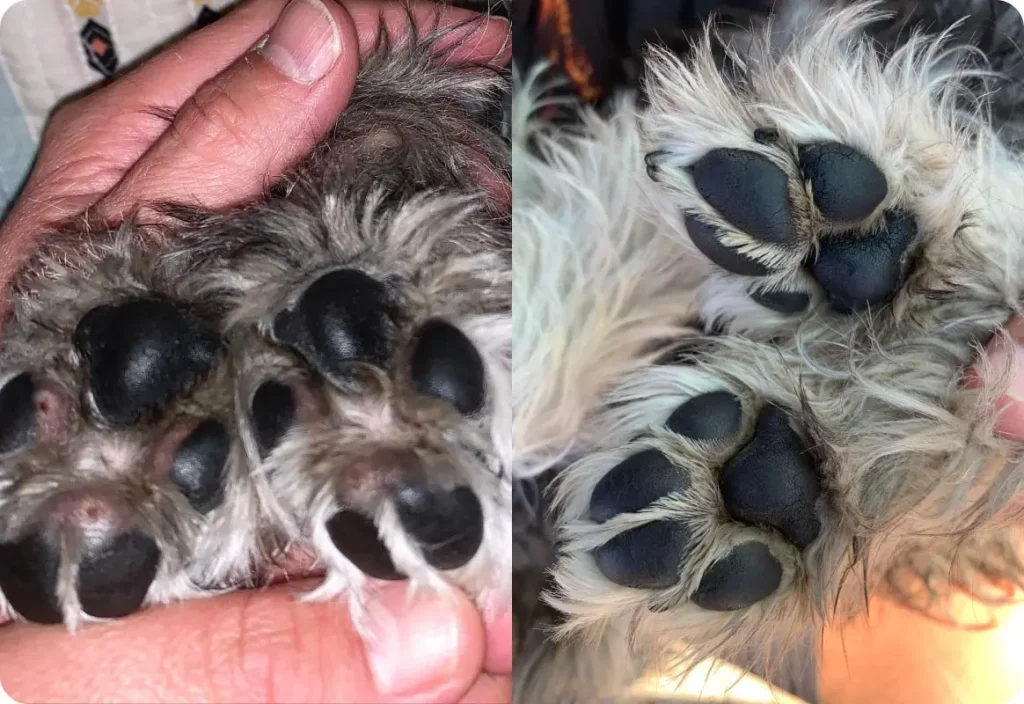
Four days after using PawPurity Healing Paw Conditioner the paws were completely healed (right)
PawPurity Paw Treatment for Dogs
By regularly using PawPurity Healing Paw Conditioner for Dogs, you can help protect your dog’s paws from the elements. This organic paw balm is made with aloe vera and mustard seed oil, which help to moisturize and heal dry, cracked paw pads.
In addition, the balm includes essential oils (Cedarwood, Marjoram, Frankincense, and Lemongrass), which provide a barrier against salt and other harsh chemicals. Using this conditioner regularly can help to keep your dog’s paw pads healthy and free from cracks and other damage.
Fun Winter Activities You Can Do With Your Dog
With the cold weather setting in, it’s important to find ways to stay active and have fun that is safe for both you and your dog. Here are a few ideas:
- Take your dog for walks in the park. Not only will this help you both get some exercise, but it’s also a great way to bond. Just be sure to dress warmly and keep an eye out for ice and other hazards.
- Play fetch in the snow. This is a great way to wear out an active dog while getting some fresh air yourself. Just be sure not to throw the ball only a little, as it may be difficult to find in the snow.
- Have a snowball fight. This one is more fun for you than your dog, but they’ll enjoy chasing the balls of snow around. Just be careful not to hit them with a snowball by accident!
These are just a few fun and healthy winter activities you can do with your dog. So get out there and enjoy the season!
When to See a Vet About Your Dog’s Paw Health?
Is your dog limping or having trouble walking? Is their paw swollen, red, or tender? It’s important to pay attention to any changes in your dog’s paw health – it could be a sign of something serious.
If you notice any signs of infection or injury, take your pup to the vet immediately. The sooner you seek professional help for a paw health concern, the better! That way, if an underlying issue needs to be addressed, such as an infection or allergies, it can be treated quickly and effectively.
It’s also important to keep an eye on any chronic conditions affecting your pup’s paws. For example, if arthritis is causing them pain when walking or running their nails too long can lead to painful sores and cuts – both of which should be looked at by a veterinarian immediately.
Summarizing
Although it is still unclear whether dog paws are truly able to handle snow, there are many precautions that pet owners can take to protect your dog’s paws and ensure their furry friends stay safe during the winter. If you live in an area with heavy snowfall, shovel a path for your dog to walk on and keep them inside when temperatures drop below freezing.
Additionally, consider purchasing boots or socks specially made for dogs to protect their paws from snow, extremely cold temperatures and salt used on roads and sidewalks. Finally, try religiously using good healing paw balm for your puppy the whole winter to avoid any serious injury and cracks.
Taking these simple precautions can help ensure your pup stays happy and healthy all winter long!
Here is a list of places the PawPurity team likes to shop for winter wear. Pajamas: In The Company of Dogs. Jackets & Sweaters: Spark Paws. Beds: The Dogs Landing. Booties: Ruff Wear.





